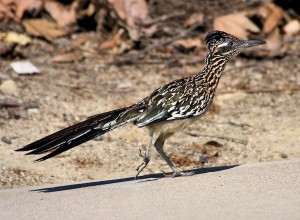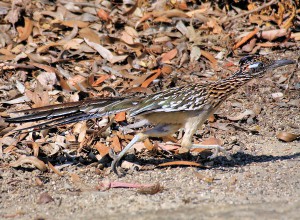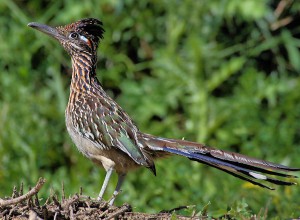Neighborhood Greater Roadrunner
High school is out for Easter vacation this week. It was fun to see our local neighborhood Greater Roadrunner on my walk this morning. He was just walking down the sidewalk next to Aliso Niguel High School. He seemed interested in the guy taking his picture too.
We are watching at Optics4Birding.
About the Greater Roadrunner
Most of us who grew up with the Warner Brothers’ Roadrunner cartoon have some of the basic facts wrong. It is true that, in real life, coyotes are one of the main predators of roadrunners. Contrary to the cartoon though, coyotes can run at speeds up to 43mph. This speed is more than twice as fast as a roadrunner’s top speed. The cartoon was a much nicer thought with the roadrunner’s “meep meep” and then zooming away from Wile E. Coyote in a cloud of dust. In the real world there are many stories of charismatic Greater Roadrunners. These stories include everything from roadrunners courting people, to tapping on their windows, to leaving them prey each morning on their doorstep.
Species
Greater Roadrunner is part of the cuckoo family. There is a smaller Lesser Roadrunner from Western Mexico (with small disjunct population in Yucatan) to Central America. The two roadrunners have only a small overlap of range in Sonora. The Greater Roadrunner has underside streaking missing on the smaller Lesser Roadrunner.
Habits, Habitat and Range
Although the roadrunner can fly it is considered a weak flier. Spending most of its time on the ground sometimes it will fly onto a low perch like a fence post. It lives in semiarid scrubland or the deserts of the South-Western United States to Central Mexico. In the US it can be found as far east as Louisiana, Arkansas, and Missouri.
Food
The Greater Roadrunner will eat most anything it can catch. It feeds on many larger insects and arthropods including tarantulas and scorpions. Lizards, snakes, mice, and small birds are also common food items. The roadrunner can jump into the air to snatch a hummingbird. There is popular discussion of its ability to catch and eat rattlesnakes. This often includes a team effort. One bird will distract the snake and the other will sneak up and attack it from behind. During winter months some fruits such as cactus fruit make up a portion of its diet.
Nesting and Brooding
Generally, the Greater Roadrunner mates for life. The pair build the nest 2-13 feet off the ground in a cactus, tree, or crotch of a sturdy bush. The nest is usually well concealed. The male gathers sticks, grass, leaves, feathers, and twigs. The female creates a platform up to 18 inches in diameter with a 4-inch-deep nest cup. The female may scold the male if he takes too long in bringing nest materials prompting him to get back to work. Both parents incubate the eggs for 19-20 days yet the male spends the greater time.



